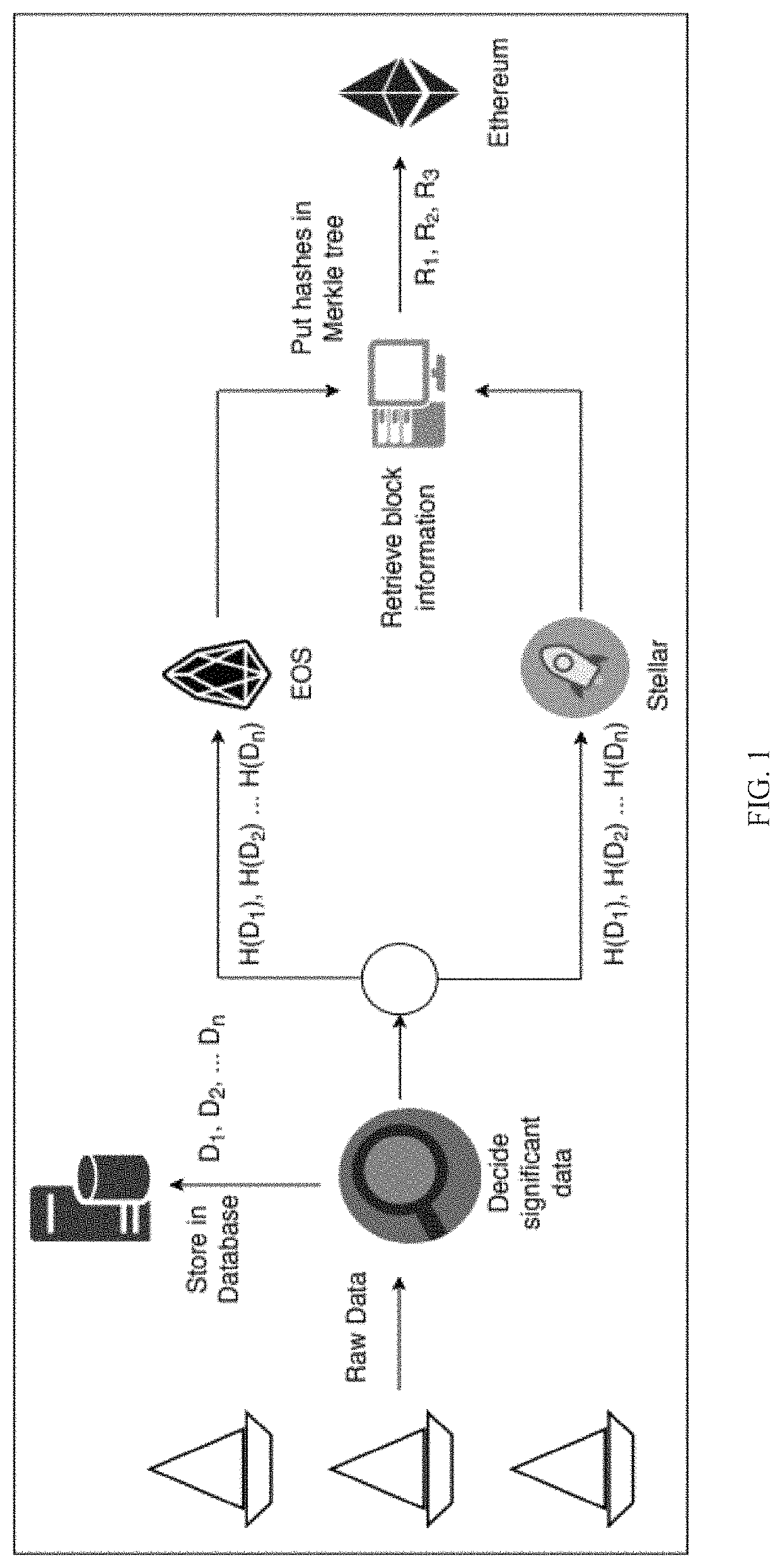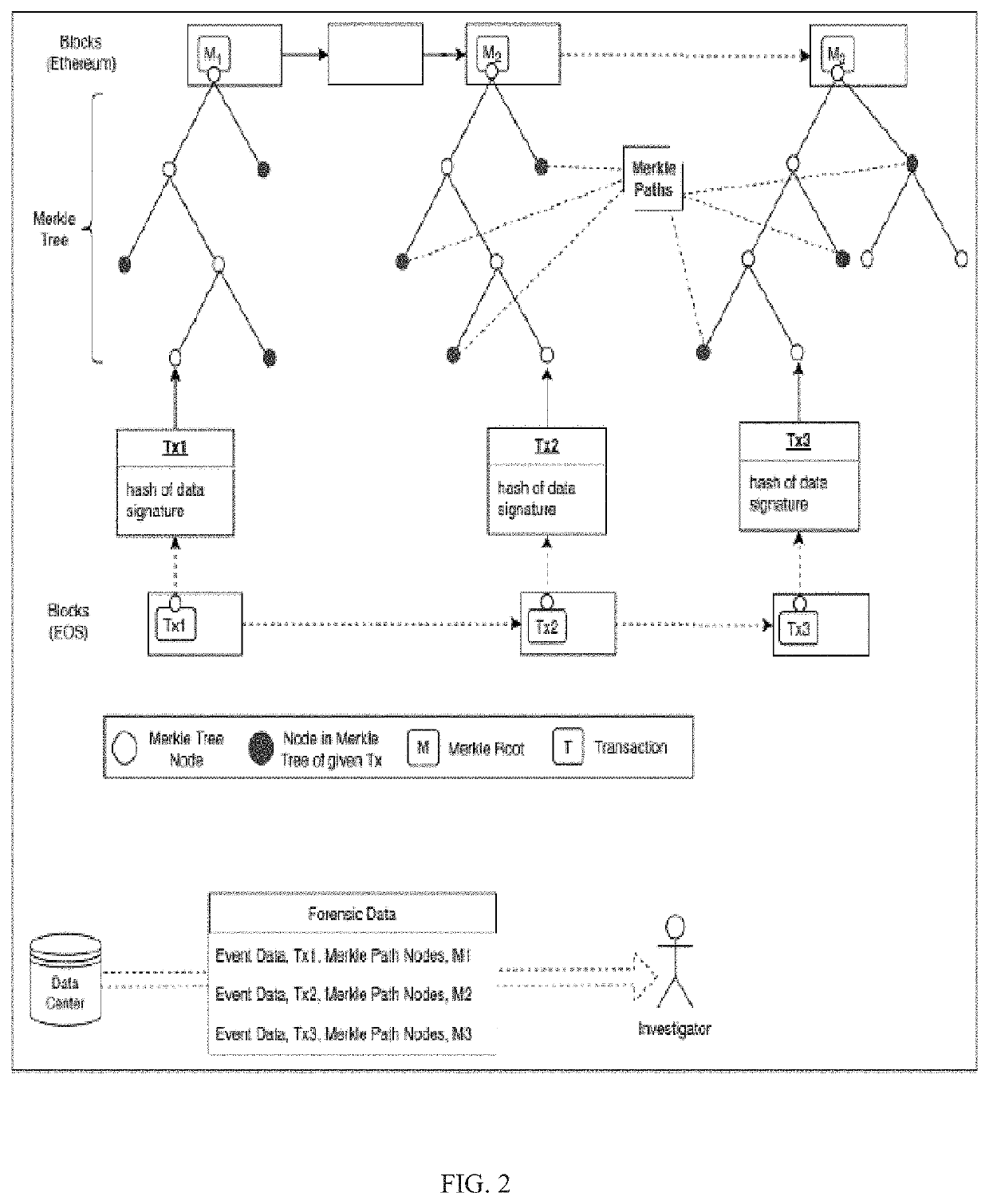Cost-efficient IOT forensics framework with blockchain
a forensic framework and blockchain technology, applied in the field of cost-efficient iot forensic framework with blockchain, can solve the problems of data storage challenges, high transaction fees, and certain costs, and achieve the effect of cost-effective and reliabl
- Summary
- Abstract
- Description
- Claims
- Application Information
AI Technical Summary
Benefits of technology
Problems solved by technology
Method used
Image
Examples
example 1
ment of a Multi-Level Blockchain Framework
[0100]In order to perform transactions in each of the mentioned blockchain platforms, their respective nodes were created. First, an EOS central node was set up, to which nodes are supposed to connect through the EOS chain plugin API. Every node (boats in this example) has its wallet and uses this wallet to connect to main EOS Network. When there is any interesting event, the IoT edge device pushes the hash of this value into EOS Blockchain via Central EOS Node. In this setup, it is possible for each wallet to track all transactions easily via history API plugin. Similarly, Stellar wallets were installed to connect to its network using theirs APIs.
[0101]Events waiting for API recalls were used to trigger smart contracts, which become ready to be deployed to a second level blockchain (e.g., Ethereum) after checking validity. An event is an interface between wallet, API, and smart contracts. Javascript API connects to Web3 interface of a secon...
example 2
ment of Benchmarks
[0103]The approach of embodiments of the subject invention was compared with two other approaches as described below.[0104]Second level blockchain (e.g., Ethereum) with new Contract: This approach creates a new a second level blockchain contract for each hash and inserts the hash in this contract. Creating a new contract for each piece of data is costly but it is a simple and secure way to store data in a second level blockchain.[0105]Function Call from a second level blockchain (e.g., Ethereum) Contract: This approach deploys a second level blockchain contract by including a function, and thus each time this function is called to save the hash instead of creating a new contract. Making a function call is a cheaper process than a new contract deployment since the contract creator pays only the contract creation fee once. However, when one smart contract is deployed and its function is called to save a new hash value, it becomes less secure. The attacker can directl...
example 3
ysis
[0106]The cost associated with the framework of embodiments of the subject invention was assessed by comparing it with the benchmarks mentioned. Before doing the complete cost analysis, the unit transaction costs associated with each blockchain platform were provided and measured for a function call to save a hash value along with the transaction verification time in Table I. It can be observed that a second level blockchain (e.g., Ethereum) unit price, even deployed with the minimum gas fee, is much higher than others. It should also be noted that EOS provides free contract deployment, but it requires to have 100 EOS in the node. Regarding the validation times, EOS and Stellar are much faster for real-time transactions. A second level blockchain (e.g., Ethereum) on the other hand is slow but since it is used at the end of the day on already stored transactions, this may be an acceptable compromise.
[0107]In doing the computations for this example, it was assumed that each boat s...
PUM
 Login to View More
Login to View More Abstract
Description
Claims
Application Information
 Login to View More
Login to View More - R&D
- Intellectual Property
- Life Sciences
- Materials
- Tech Scout
- Unparalleled Data Quality
- Higher Quality Content
- 60% Fewer Hallucinations
Browse by: Latest US Patents, China's latest patents, Technical Efficacy Thesaurus, Application Domain, Technology Topic, Popular Technical Reports.
© 2025 PatSnap. All rights reserved.Legal|Privacy policy|Modern Slavery Act Transparency Statement|Sitemap|About US| Contact US: help@patsnap.com



